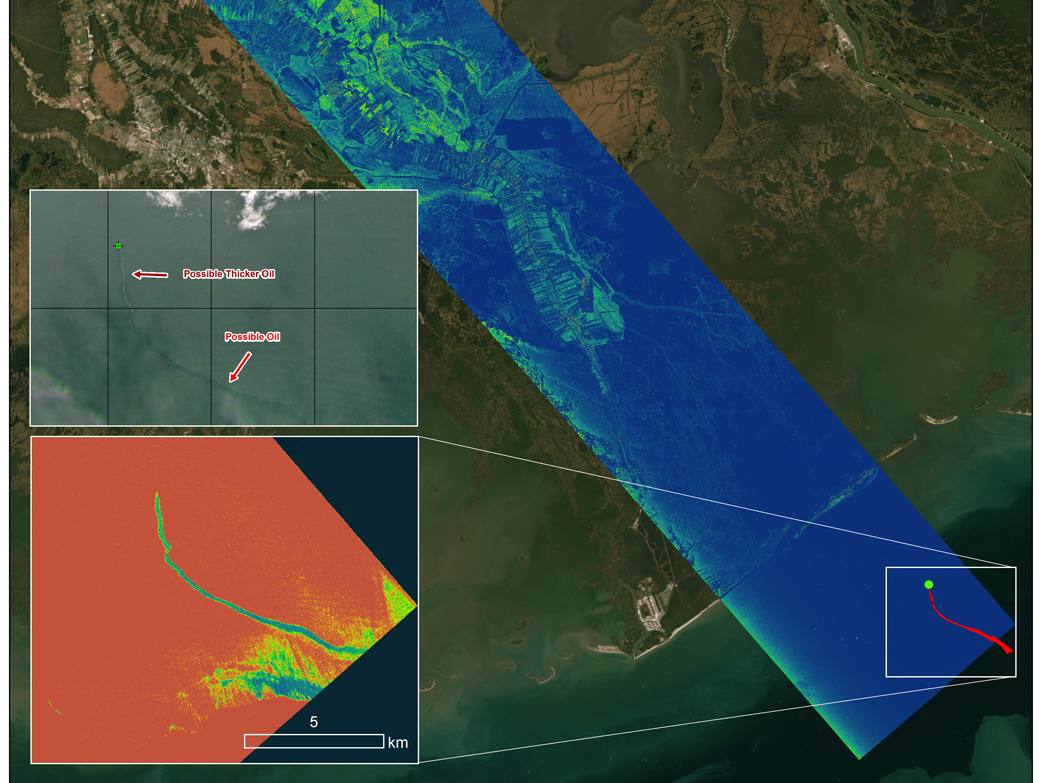Researchers flying a radar instrument over coastal wetlands in Louisiana helped with monitoring oil slicks in the Gulf of Mexico.
Charged with studying the Mississippi River Delta, NASA’s Delta-X project was gearing up to collect data on Louisiana’s coastal wetlands when Hurricane Ida barreled ashore in late August. The storm – a high-end Category 4 when it made landfall near Port Fourchon, Louisiana, on Aug. 29 – damaged buildings and infrastructure alike, resulting in power outages, flooding, and oil slicks in the Gulf of Mexico.
The National Oceanic and Atmospheric Administration (NOAA) regularly monitors U.S. coastal waters for potential spills and noticed some slicks that appeared just off the coast after the hurricane. They were able to use Delta-X radar data to corroborate the presence and location of these oil slicks.
Oil tends to smooth out the bumps on the ocean’s surface, which results in a distinct radar signal that the Delta-X mission was able to pick out of their data. In the false-color inset graphic above, the oil appears as a green trail, while the surrounding seawater appears orange. NOAA used this information to corroborate other data they had about oil slicks in the area (satellite image in the second inset picture). In the larger image, the blue-green swath crossing from the Gulf of Mexico over the Louisiana coast denotes the flight path of the radar instrument on Sept. 1, just before 11:30 a.m. CDT. Delta-X added flight paths to their planned schedule – with the support of NASA’s Applied Science Disaster Program – in order to collect information over the Gulf in areas of interest to NOAA.
The Delta-X mission is studying two wetlands – the Atchafalaya and Terrebonne Basins – by land, boat, and air to quantify water and sediment flow as well as vegetation growth. While the Atchafalaya Basin has been gaining land through sediment accumulation, Terrebonne Basin, which is next to the Atchafalaya, has been rapidly losing land. The data collected by the project will be applied to models used to forecast which areas of the delta are likely to gain or lose land under various sea level rise, river flow, and watershed management scenarios.
The mission uses several instruments to collect its data. Affixed to the bottom of a Gulfstream-III airplane, one of those instruments, the all-weather Uninhabited Aerial Vehicle Synthetic Aperture Radar (UAVSAR), bounces radar signals off of Earth’s surface, creating an image of a particular area. Repeated images of the same regions, captured at different times, enable researchers to detect changes in those areas, such as fluctuating water levels beneath the vegetation as the tides move in and out of these wetlands. In addition to radar measurements, teams from Caltech, Louisiana State University, Florida International University, and other collaborating institutions gather water and vegetation samples – among other data – by boat, other airborne sensors, and from instruments on the ground.
Funded by NASA’s Earth Venture Suborbital (EVS-3) program, Delta-X is managed by the agency’s Jet Propulsion Laboratory. Caltech in Pasadena, California, manages JPL for NASA. Fall 2021 was Delta-X’s last scheduled field campaign, although the five-year mission will run through the end of 2023.
To learn more about the Delta-X mission, visit:





























